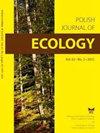波兰西波美拉尼亚三种野鸭寄生线虫群落结构
IF 0.7
4区 环境科学与生态学
Q4 ECOLOGY
引用次数: 1
摘要
摘要比较了来自波兰西波美拉尼亚地区的绿头鸭(Anas platyrhynchos)、簇绒鸭(Aythya fuligula)和普通黑鸭(Melanitta nigra)三种野鸭胃肠道线虫群落。线虫是普通苏格兰蠕虫动物群中数量最多的群体,绿头鸭中数量第二多的群体,簇绒鸭中数量最少的群体。从366只鸭子中分离到14种5348种线虫。在绿头鸭中发现6种线虫(607个体),在簇绒鸭中发现5种线虫(493个体)和在普通鸭中发现7种线虫(3576个体)。簇绒鸭的线虫区系具有最高的物种均匀性,而普通斯科特线虫区系则具有最大的物种多样性。动物区系相似性分析显示,绿头鸭和普通黑鸭有一种常见的寄生物种(钩状环口虫),簇绒鸭和普通落鸭有三种常见的寄生虫物种(雷吉科维四齿目、棘突棘突齿目和棘突下颌目)。就线虫的空间分布而言,大多数线虫主要分布在腺胃(绿头鸭占所有线虫的84%,簇绒鸭占40%)和砂眼(簇绒鸭为56.6%,普通暗纹鸭为74%),而只有扭曲真油菌和尖贝母属的个体位于食道和肠道。结果证实,三种鸭的系统发育差异及其生态学的差异伴随着寄生线虫群落结构的差异。本文章由计算机程序翻译,如有差异,请以英文原文为准。
Parasitic Nematode Community Structure in Three Wild Duck Species from Western Pomerania, Poland
ABSTRACT Nematode communities of the gastrointestinal tract in three species of wild ducks: mallard (Anas platyrhynchos), tufted duck (Aythya fuligula) and common scoter (Melanitta nigra), from the area of Western Pomerania in Poland, were compared. Nematodes were the most numerous group in the helminth fauna of the common scoter, the second most abundant group in the mallard and the least numerous group among parasites found in the tufted duck. A total of 5348 nematodes belonging to 14 species were isolated from 366 examined ducks. Six nematode species (represented by 607 individuals) were found in mallard, 5 species (493 individuals) in tufted duck and 7 species (3576 individuals) in common scoter. Nematofauna of tufted duck was characterized by the highest species evenness, while the nematofauna of common scoter presented the greatest species diversity. The analysis of fauna similarity showed one common parasitic species (Epomidiostomum uncinatum) for mallard and common scoter, and three species (Tetrameres ryjikovi, T. spinosa and Echinuria hypognatha) for tufted duck and common scoter. Regarding the spatial distribution of nematodes most of them primarily reside in the proventriculus (84% of all nematodes in mallard and 40% in tufted duck) and gizzard (56.6% of all nematodes in tufted duck and 74% in common scoter), whereas, only individuals of the species Eucoleus contortus and Capillaria anatis were located in the oesophagus and intestine. The results confirm that the phylogenetic differences of the three duck species, as well as the differences in their ecology are accompanied by differences in the structure of parasitic nematode community.
求助全文
通过发布文献求助,成功后即可免费获取论文全文。
去求助
来源期刊

Polish Journal of Ecology
环境科学-生态学
CiteScore
1.10
自引率
0.00%
发文量
9
审稿时长
18-36 weeks
期刊介绍:
POLISH JOURNAL OF ECOLOGY (formerly Ekologia polska) publishes original scientific research papers dealing with all aspects of ecology: both fundamental and applied, physiological ecology, evolutionary ecology, ecology of population, community, ecosystem, landscape as well as global ecology. There is no bias regarding taxons, ecosystems or geographical regions.
 求助内容:
求助内容: 应助结果提醒方式:
应助结果提醒方式:


